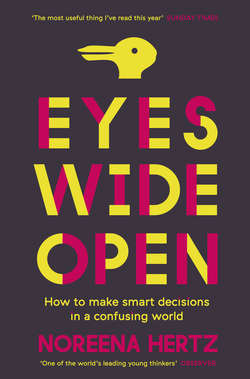Читать книгу Eyes Wide Open: How to Make Smart Decisions in a Confusing World - Noreena Hertz - Страница 19
The Cult of the Measurable
ОглавлениеIt’s not only particular forms of presentation that can blinker our vision.
One type of information often dominates our attention – numbers. This in itself can be problematic.
Numbers can give us critical information – if we want to know whether to put a coat on, we’ll look at the temperature outside; if we want to know how well our business is doing, we’ll need to keep an eye on revenues and expenditures; and if we want to be able to compare the past with the future, we’ll need standard measures to do so.
But the problem is that the Cult of the Measurable means that things that can’t really be measured are sometimes given numerical values.21
Can a wine really be 86 per cent ‘good’? That doesn’t sound right to me, but one multi-billion-dollar industry doesn’t agree. Robert Parker, probably the most famous wine critic in the world, ranks wines on a scale between fifty and one hundred. And winemakers prostrate themselves before him, praying for a rating of ninety-two or above, because such a number practically guarantees commercial success, given how influential Parker’s ratings have become with wine drinkers.22
Yet what really is the difference between a rating of ninety-two and an eighty-six? How can we tell what that six-point difference means?
And are someone else’s tastes necessarily going to correlate with yours? I’ve already raised the question of whether Joe from Idaho on TripAdvisor is really the best person to steer your choice as to where to go on holiday. We also need to ask ourselves whether what I mean by four stars is what you mean by four stars. Whether my Zagat score of twenty means the same as yours. As the Financial Times’s wine critic Jancis Robinson points out on the subject of Parker’s influence, ‘Make no mistake about it, wine judging is every bit as subjective as the judging of any art form.’23
So, before you make a decision based on a number, think about what the number is capturing, and also what it is not telling you.
Risk is another area where our attempts to assign clear measures are often bound to fail. While it’s true that there are some areas where we can meaningfully quantify risk – such as engineering, where we can come up with a number for how likely a building is to withstand an earthquake, say; or medicine, where we can estimate a patient’s chance of responding to a particular drug – this approach doesn’t work effectively in all spheres. Indeed, in our turbocharged world, in which changes happen quicker and less predictably than ever before, many of our attempts to assign probabilities to future events are likely to be pretty meaningless. As President Obama said, reflecting on the huge range of probabilities that various senior intelligence folk had proffered back in March 2011 as to whether Osama bin Laden was the ‘high value target’ spotted within a high-walled compound in Abbottabad in Pakistan – with confidence levels that ranged between 30 and 95 per cent – ‘What you started getting was probabilities that disguised uncertainty as opposed to actually providing you with more useful information.’24
In our desire to reduce everything to some sort of standardised measure, to create universal meanings for things that will always be subjective, and to create the illusion of certainty when uncertainty is in fact what prevails, do we not risk making decisions on the basis of what may seem intelligence-rich information, but is in truth pretty meaningless?
Not everything can be measured, not everything can be compared, especially in a world as complex as ours. Indeed, Obama, realising this, responded to the various probabilities he’d been presented with, ‘Look guys, this is a flip of the coin. I can’t base this decision on the notion that we have any greater certainty than that.’25 A flip of the coin which we now know that President Obama won and Osama bin Laden lost.
